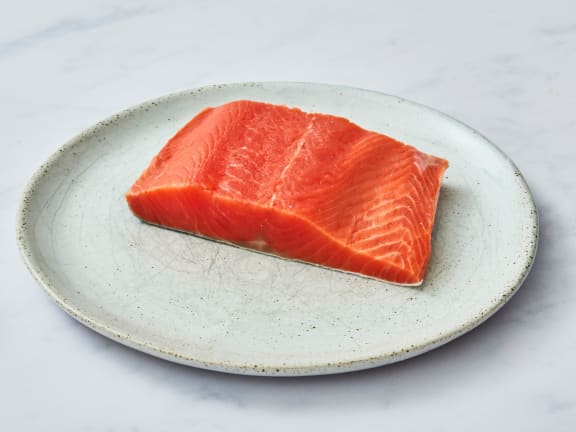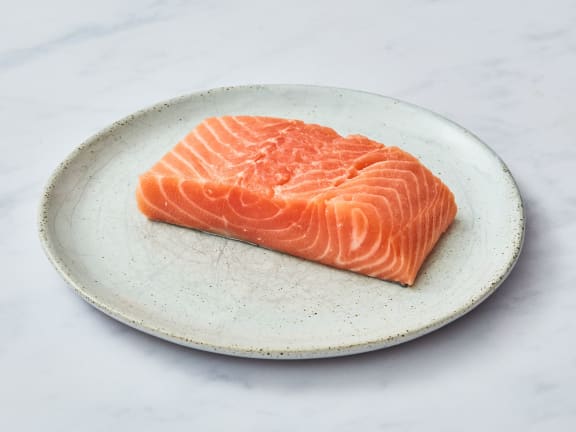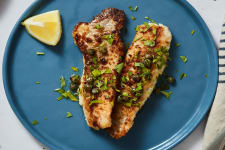A note from Founder & CEO Arron Kallenberg: At Wild Alaskan Company, we honor salmon as the lifeblood of multiple ecosystems. The natural journey salmon take during their lifetimes transfers nutrients from the oceans to the rivers, lakes and streams. It’s that very journey that makes wild salmon such a powerhouse of nutrients and color. In contrast, farmed salmon are raised in stagnant, manmade systems that try (and fail) to recreate what nature does best. When it comes to our health and the health of our oceans, we believe nature does know best, and we strive to participate in the natural process in a responsible, sustainable way. We’re exploring the fundamental reasons we believe sustainably-managed wild salmon is the best choice for you and the planet. Read on for more.
Public health experts generally have recommended salmon as a “healthy” protein option that more Americans need to include in their diets regularly. But when you compare farmed salmon to wild salmon, the choice is obvious.
Here are a few key reasons why wild salmon is the only choice when it comes to health.
The Rundown: Wild Salmon over Farmed Salmon
-
Wild salmon is low in contaminants — a clean source of protein that you can feel good about eating.
-
Farmed salmon could often be highly contaminated with toxins that are harmful to human health.
-
Wild salmon are naturally a vibrant shade of pink or red because of their diet of wild crustaceans and zooplankton.
-
Farmed salmon requires an input of synthetic additives in order to become pink in color. Without this dye, farmed salmon would be grey.
-
Wild salmon naturally are a source of omega-3 fatty acids, so you can get your nutrition straight from the source.
-
Farmed salmon are increasingly fed plant-based diets deficient in omega-3 fatty acids, negatively affecting their overall fat composition.
-
Wild salmon contain a balance of omega-3 fatty acids that is associated with a reduced risk of chronic illness.
-
Farmed salmon are more abundant in omega-6s comparatively to wild, which means their omega-3s aren’t fighting as hard for your health.
Wild salmon escape added contaminants.
When you choose wild salmon, you’re getting everything you might expect: vitamins, minerals, healthy fats. With farmed salmon, you’re getting a lot more that you might want to think twice about.
Studies over the past couple of decades have consistently found that farmed salmon from conventional fish farms are typically contaminated with high levels of PCBs, dioxins, and pesticides; all contaminants that are associated with an elevated risk of cancer, endocrine disorders, and developmental defects. One analysis by the Environmental Working Group concluded that 7 out of every 10 farmed salmon fillets from U.S. grocery stores contained significant levels of contamination, much of which can be traced back to toxins present in fish feed.
Without any intervention from humans — no added pesticides, no contaminated feed, no antibiotics — wild salmon from Alaska are capable of living their best salmon lives, free to roam through naturally flowing waters to hunt for wild prey, as they’ve done for ages. With access to these natural conditions, wild salmon are rich in nutrients, and not in contaminants.

Wild salmon naturally bursts with color and nutrients.
Without synthetic additives, farmed salmon wouldn’t be pink. They’d be grey!
Wild salmon eat shrimp and krill. Both are rich in an antioxidant called astaxanthin, a bright red carotenoid. This wild diet naturally gives wild salmon some of its antioxidant properties, as well as its signature color. Fun fact: Sockeye salmon consume the most shrimp and krill of all the species, which is why its fillet is the reddest of them all (and, unsurprisingly, why it’s nicknamed “red salmon”).
To mimic this natural coloring, farmed salmon are often fed soy- and corn-based pellets that are supplemented with synthetic astaxanthin, a compound often derived from petrochemicals. Research seems to suggest that the synthetic astaxanthin used to dye farmed salmon is significantly less bioavailable as a nutrient than naturally derived sources — about 20 to 30 times more less potent. But it’s not clear if synthetic astaxanthin has any tangible benefits beyond aesthetics anyway, as it’s not actually approved as an antioxidant supplement for human consumption, only as a pigment.

Wild salmon delivers omega-3s, free of additives.
In addition to shrimp and krill, wild salmon are able to consume small prey fish that are rich in EPA and DHA, the two types of omega-3 fatty acids that are almost exclusively found in seafood. This natural diet is why wild salmon are such a balanced source of omega-3s. These essential nutrients are said to have potent anti-inflammatory properties that help to fend off oxidative stress and support heart health, benefits that place wild salmon in the pantheon of healthy foods.
In an attempt to boost farmed salmon with omega-3s, many aquaculture operations use plant-based pellets supplemented with fish oil derived from wild prey fish as feed. In other words, wild fish are being harvested to supplement processed pellets to feed farmed fish in an attempt to mimic the nutritional benefits of wild fish... which begs the question: Why not just eat wild fish to begin with?
What’s more, there’s some uncertainty as to whether or not farmed salmon may not pack as many omega-3 fatty acids as they used to. One study found that omega-3 fat levels had dropped so low due to these changes in their feed that you would need to purchase and eat double the amount of farmed salmon to reach your recommended daily intake of these fatty acids.
Wild salmon boasts a better balance of essential fats.
Farmed salmon consume an overabundance of omega-6 fatty acids from plant-based fish feeds, and that makes them much higher in omega-6s for us (after all, you are what you eat). The health implications of this are not fully understood, but past research has suggested that a relative glut of omega-6s in one’s diet is tied to an increased risk of chronic illness. One nutritional study found that the typical, suboptimal Western diet has a 15:1 ratio of omega-6s to omega-3s — in other words, too many omega-6s and too few omega-3s.
A lower dietary ratio — 5:1 or less — is more closely aligned with what our bodies evolved to eat and is associated with a significantly lower risk of certain cancers, heart disease, and inflammatory diseases. Wild salmon, when compared to farmed, has a more favorable omega-3 to omega-6 ratio that can help us get closer to this balance of fatty acids, better positioning us to lead healthier lives.
Overall, studies for decades have shown that wild salmon is a better choice for health across a range of considerations. When it comes to nutrition and our diets, “healthy” can feel like a moving target, especially as there’s no real one source of truth we can look towards. As always, we’re committed to staying informed as new information reveals itself. But in the end, we believe that Mother Nature does indeed know best.






